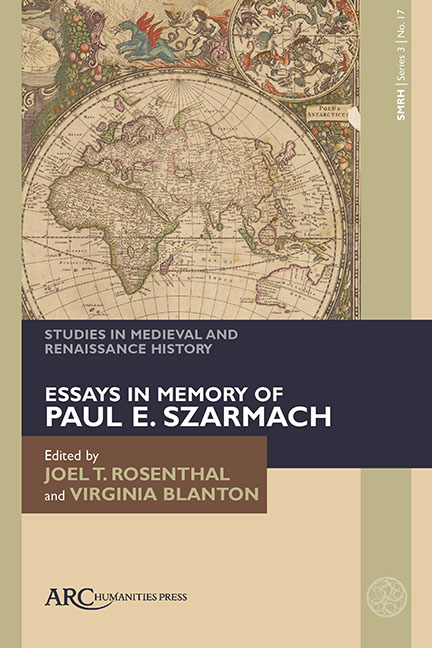Book contents
- Frontmatter
- Contents
- List of Illustrations
- Introduction
- Memories of Viking Age Cultural Contact: England in the Íslendingasögur
- Expressions of Cultural Disability: Navigating (Non)Normativity in the Hebrew–Italian Melekh Artus (King Artus)
- “All the rancour and enmity between us”. The War Between Richard, Earl Marshal, and King Henry III: Its Origins and Resolution
- Royal Consumption and Gifts of Deer in Thirteenth-Century England
- Travers and Trappe in the Palace of Pandarus: A Note
- Benedictine Devotion to England’s Saints: Thomas de la Mare, John of Tynemouth, and the Sanctilogium in Cotton Tiberius E. i
- The Rise of Admission by Apprenticeship Among the Freemen of Norwich, 1365–1415
- Nuns on the Run, or the “Sturdy and Wilful Dames” of Syon Abbey and their Disobedience to the Tudor State ca. 1530–1600
- Taking the Tour: Heritage Management in A Connecticut Yankee in King Arthur’s Court
Nuns on the Run, or the “Sturdy and Wilful Dames” of Syon Abbey and their Disobedience to the Tudor State ca. 1530–1600
Published online by Cambridge University Press: 13 February 2024
- Frontmatter
- Contents
- List of Illustrations
- Introduction
- Memories of Viking Age Cultural Contact: England in the Íslendingasögur
- Expressions of Cultural Disability: Navigating (Non)Normativity in the Hebrew–Italian Melekh Artus (King Artus)
- “All the rancour and enmity between us”. The War Between Richard, Earl Marshal, and King Henry III: Its Origins and Resolution
- Royal Consumption and Gifts of Deer in Thirteenth-Century England
- Travers and Trappe in the Palace of Pandarus: A Note
- Benedictine Devotion to England’s Saints: Thomas de la Mare, John of Tynemouth, and the Sanctilogium in Cotton Tiberius E. i
- The Rise of Admission by Apprenticeship Among the Freemen of Norwich, 1365–1415
- Nuns on the Run, or the “Sturdy and Wilful Dames” of Syon Abbey and their Disobedience to the Tudor State ca. 1530–1600
- Taking the Tour: Heritage Management in A Connecticut Yankee in King Arthur’s Court
Summary
Syon Abbey, a House of Prayer for England's Royal Dynasties ca. 1415–1559
IN 1535, SR. Agnes Smythe of Syon was called “a sturdy dame and a wilful” by Henry VIII's officer for voicing opposition to Royal Supremacy over the Anglican Church. This is one of three recorded incidents of defiance by the nuns which took place at this turbulent time. They lift the veil on life within the strict enclosure of this reformist community and reveal that the sisters, not just the more celebrated brothers, rejected Henry VIII's new policy. That same year, the nuns were said to have met Queen Anne Boleyn's visit to Syon with passive disobedience, refusing to allow her in to distribute Protestant literature. After his officers had failed, Henry VIII's minister Thomas Cromwell ordered Syon's steward, Andrew, Lord Windsor, to secure his kinswomen's submission to the Royal Supremacy, and they again refused. To discover how such opposition to their royal master could have arisen in this model religious community, this study explores the fifteenth-century origins of Syon's defiance of the Tudor state and its consequences in the sixteenth century.
In 1415, the Lancastrian king Henry V founded Syon Abbey as the only British house of the Order of St. Savior, popularly known as the Birgittines. St. Birgitta of Sweden (1303–1373), a relative of the Swedish royal family, established her order for nuns as part of a wider movement for church reform and renewal. Henry V founded Syon to invoke the saint's support for the English victory she had prophesied in the Hundred Years’ War against France. The foundation was important diplomatically, as it followed the 1406 marriage of his sister Philippa to Eric of Pomerania, ruler of Sweden. The Birgittines and the Carthusians were the leading religious orders sponsored by Northern Europe's rulers to promote Humanist church reform. Syon Abbey was a house of prayer for all the royal dynasties of the Wars of the Roses, Lancaster, York, and Tudor. Each regime populated Syon with religious from loyal families to pray for them, up to sixty sisters and up to twenty-five brothers who provided the sacraments.
- Type
- Chapter
- Information
- Studies in Medieval and Renaissance History series 3 volume 17Essays in Memory of Paul E. Szarmach, pp. 147 - 168Publisher: Amsterdam University PressPrint publication year: 2023



